Hi Everyone!! This article will share Emily Dickinson Most Famous Poems.
It is not an easy task to list ten most famous poems of Emily Dickinson however, we have tried to do so.
Emily Dickinson Most Famous Poems
Before going further with the list, let me give you a brief description about her.
Who is Emily Dickinson?
Born on 10 December 1830, in Amherst, Massachusetts, Emily Dickinson changed the definition of poetry. Grew up in a prominent and successful household, Emily was an introvert who seldom came out of home or interacted with people. Though she withdrew from public life, the people with whom she did come in contact had an enormous impact on her poetry. She was particularly moved by the Reverend Charles Wadsworth and he held an important position in her life. She called him ‘my closest earthly friend.’
Emily drew upon her knowledge of the Bible, classical myths, and Shakespeare for references in her poetry. John Keats as well as Robert and Elizabeth Barrett Browning were among a few poets who inspired her. Her poems are filled with insight gained from personal experiences, domestic duties, bees, winter light and household items. She has focused upon the topics such as nature, grief, joy, love, death, faith, doubt, pain, and the self. Emily Dickinson is regarded as one of America’s greatest poets however, she did not get much recognition during her lifetime. The first volume of her work was published posthumously in 1890 and the last in 1955. She died in Amherst in 1886.
Emily Dickinson Most Famous Poems
1. Hope is the Thing with Feathers
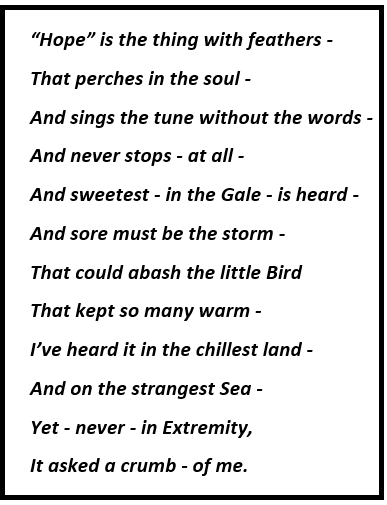
In this poem, the poet mentions ‘hope’ as a positive approach towards life and implores readers to make good use of it. She says that no human can live without the ray of hope. She portrays hope as a bird that lives inside the human soul and just as wings help the birds to fly similarly, human beings’ life is enjoyed and nourished by the feathers of hope. The poet has heard the bird sing during the hardest, coldest times when emotions are churning and life surreal. But even when things are extreme, hope is still there and never asks for anything. She says this to show the perpetuity of hope. Hope exists in the cruelest of time, never asking anyone for anything in return.
Must Read: Hope is the Thing with Feathers Questions & Answers
2. A Bird Came Down The Walk
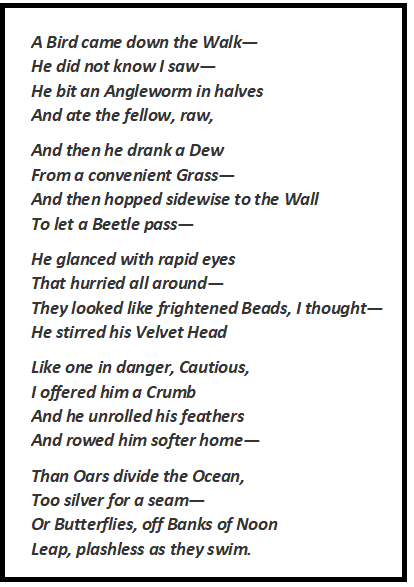
The poem is about a normal occurrence in nature of bird searching for its food and its interaction with a human being. The poet encounters a bird on the walk who eats an angle-worm, drink a dew from grass and then steps aside to let a beetle pass. The bird was looking here and there to find out whether someone was watching him. The poet loved that bird and felt pity for him. She saw that he was eating an angle worm which was raw. So, she offered a bread crumb to the bird but the bird spread out its feathers and flew away. For this, the poet says that ‘Nature is self-sufficient’. We should not disturb them and should not interfere into their lives.
Must Read: A Bird Came Down The Walk Questions & Answers
3. I Dwell in Possibility
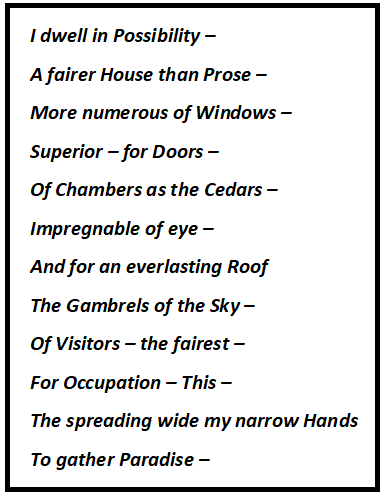
This poem celebrates poetry itself and the poet compares poetry and prose to two houses, preferring the one having more doors and windows, implying vastness of poetry. Poet also tied poetry to nature. Its rooms ‘as the cedars’ and its roof made up by the sky. This sky-roof also emphasizes poetry’s limitlessness as there is no upper boundary except the seemingly endless sky. Nature, power of poetry and joy are the major themes of the poem. In the poem, the poet says that poetry has an ultimate power and it can turn impossible things into possible ones.
Must Read: I Dwell in Possibility Questions & Answers
Emily Dickinson Most Famous Poems
4. A Narrow Fellow in The Grass
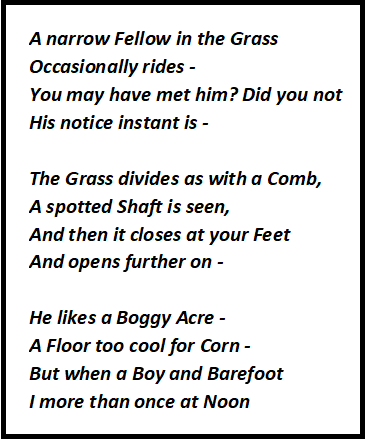
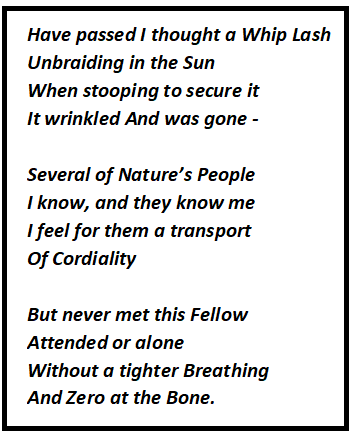
This poem is about a thin long snake with a spotted skin which is often seen moving quickly just below or at the level of the grass on wet farmland. The poem shows how the poet feels both a deep fear of snake’s mysterious ways and a strange fascination for its strange beauty. The poet feels that what seems to be a perfectly normal moment, a hidden danger might lurk.
Must Read: A Narrow Fellow in The Grass Questions & Answers
5. A Day
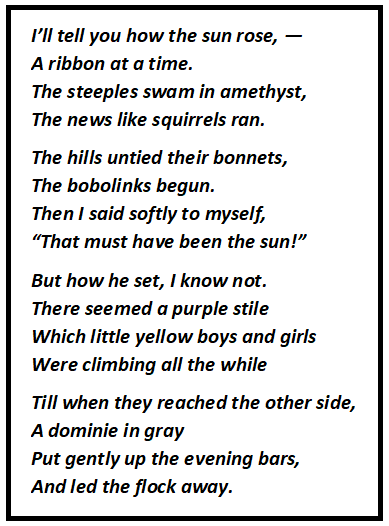
This poem deals with the theme of birth and death. Here, the rising sun symbolises birth and the sunset symbolises death. The speaker wants to tell us about what happened when the sun rose and what happened when it set. As the sun rises and sets, accordingly our life starts and ends. In this period, all the people and living things do their daily chores. When the Sun rises, the hills seem to remove their bonnets and the bobolinks sing. The rays fall in beams and light up the place. Everyone talks about the sunrise. When the sun sets, the children who were out at play go over the hill and seem to disappear as they go home. The sunset is symbolized to death. When a person gets old and dies then, the soul goes to his/her destination passing all the barriers. The speaker doesn’t know how the sun sets. It means the speaker doesn’t have an idea how the time passes from morning to evening. All the people on the earth are busy in their deeds but nobody knows when the death will come to his/her door.
Must Read: A Day Questions & Answers
6. I’m Nobody! Who are you?
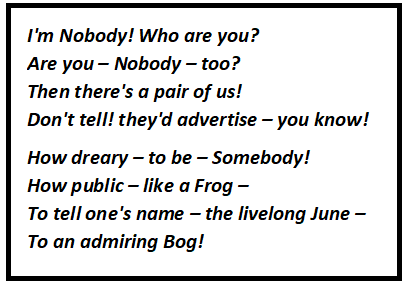
In this poem, the poet tells the difference between an identity lived privately and one lived true to oneself—and the circus of life in the public eye. She wonders: she knows what it is like to be a person with a name, an address, a family but what would it be like to be no one at all. What would it like to be nobody and would anyone want to be nobody with her?
7. Success is Counted Sweetest

This poem is based on the theme that the meaning of success can better be understood by those who have met failures in its pursuit. The poet claims that the soldiers who are dying on the battleground better know the importance of victory. She feels that people don’t value success after getting it and it can be valued by only those who are still in the pursuit of the same.
8. The Heart asks Pleasure – First

In this poem, the poet explains that the heart wants to have pleasure and live life to the fullest. A person’s heart asks for a life without pain but sometimes the pain becomes so overwhelming that a cure, escape, or even death would be a better relief.
So, these were Emily Dickinson Most Famous Poems.